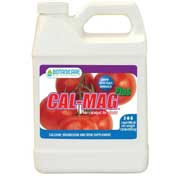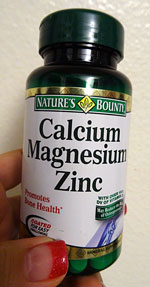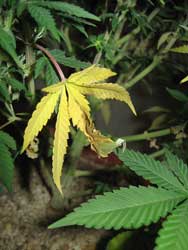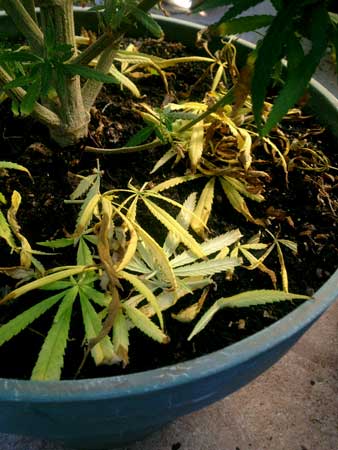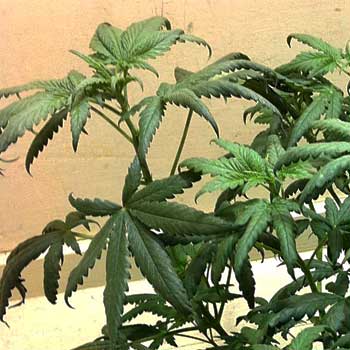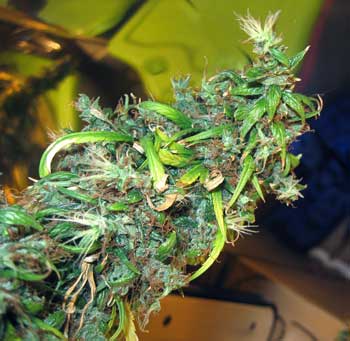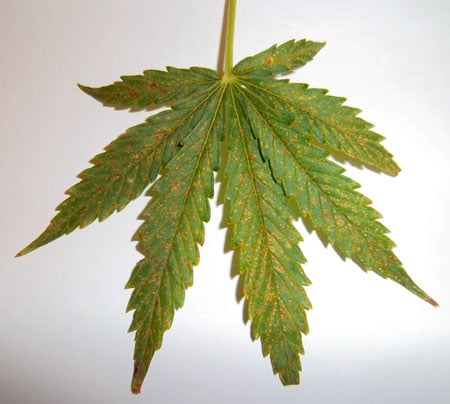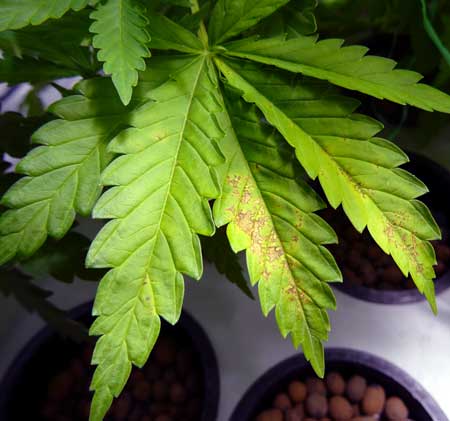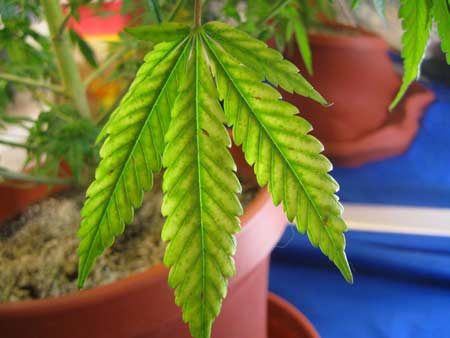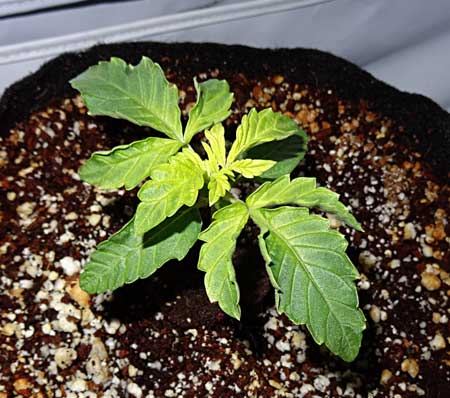by Nebula Haze
Here’s the short-and-sweet, cheat-sheet version:
You may need more nitrogen (N) if…
- Bottom leaves are wilting, turning yellow, and falling off on their own
You may need less nitrogen (N) if…
- Plant is in the flowering stage
- Leaves are dark green
- Leaf tips are clawed
You may need a Cal-Mag supplement if…
- Using reverse osmosis (RO) or soft water
- Growing in coco coir
- Your plant is showing a deficiency in Calcium (brown spots), Magnesium (lower leaves turn yellow between the veins) or Iron (bright yellow new growth) even though the pH is correct
- Some growers always include a Cal-Mag supplement
Cannabis plants grow best when they’re getting the nutrients they need at the right time. Humans are the same way; if we’re missing certain vitamins it limits our growth when we’re young, and as we get older a lack of vitamins causes us to become sick in strange ways. Conversely, humans can also run into problems when they get an overabundance of vitamins.
Just like humans with vitamins, giving cannabis too high levels of nutrients can also cause problems. Like many things in life, cannabis plants (and plants in general) need a sort of balance.
Luckily, for the most part, cannabis plants are not too picky about nutrients despite what nutrient companies might have you believe.
Cannabis is generally not that picky about nutrients, except for a few…
Your cannabis plants can tolerate a wide range of environments, but there are a few nutrients which tend to cause problems more often than others. If these nutrients aren’t present in the correct amounts, it will affect your growth rates, as well as the quality and quantity of your buds.
That being said, most of the time, nutrient deficiencies are caused by the wrong root pH, not from needing more nutrients.
Most nutrient deficiencies are caused by the wrong root pH, but sometimes you actually need to add more or less of a particular nutrient for plants to grow their best.
A few major nutrients often cause problems that are not related to pH. Although pH can be the culprit, these nutrients often need to be provided in higher or lower doses to prevent deficiencies/toxicities.
Many growers need more or less of these nutrients for proper cannabis growth and bud formation:
Nitrogen
Calcium
Magnesium
Nitrogen (N)
First, there’s nitrogen…Nitrogen makes up more of your plant (as a percentage of dry mass) than pretty much any other nutrient or mineral, and it plays a hand in many plant processes.
Without an external source of nitrogen, your plant cannot grow past its first or second set of leaves. Nitrogen is that important to growth and photosynthesis.
With nitrogen, you can get both deficiencies and toxicities.
Here’s what to look out for…
Symptoms of Nitrogen Deficiency
- Lower growth on the plant turns yellow and sometimes the yellow leaves get brown splotches.
- Affected leaves become soft and start wilting.
- Once the leaf has wilted, it sometimes dries up and turns crispy.
- Leaves fall off the plant on their own; a gentle tug will remove affected leaves.
- If left unchecked, a nitrogen deficiency will climb up the plant.
- There are other nutrient problems that cause the lower leaves of a cannabis plant to turn yellow, but only a nitrogen deficiency causes leaves to become soft enough to fall off on their own.
It is normal to lose a few leaves to nitrogen deficiencies here and there, especially if you have a lot of lower leaves that are receiving low amounts of light. It’s also normal to see nitrogen deficiencies in the second half of the flowering stage as the plants are focusing on buds instead of leaves.
However, if you see a nitrogen deficiency early in the plant’s life, or if you’re losing tons of leaves at once, a nitrogen deficiency needs to be addressed immediately.
But it’s not just too little nitrogen that causes problems. Often, you’ll see problems caused by too much nitrogen; a nitrogen toxicity.
Symptoms of Nitrogen Toxicity
- Leaves can become dark green and sometimes shiny looking
- Tips of leaves are bent sharply down in what’s known as “the Claw.”
- Buds grow slowly and final taste/smell is not as good as normal.
Leaf tips pointing down from nitrogen toxicity
Here’s what a nitrogen toxicity looks like during flowering. This much nitrogen during the budding stage will cause buds to develop more slowly and reduce overall yields. Plus, nitrogen-burnt buds tend to carry a “hay” or “fresh-cut grass” taste/smell even after being harvested and cured.
Many new growers accidentally give their plants too much Nitrogen, especially in the flowering stage
As a grower, you’re interested in how much nitrogen to give your plants at a specific time. The ratio of nitrogen to other nutrients has a huge effect on growth and bud formation.
Vegetative Stage – higher levels of nitrogen (pretty much any plant food will do)
Most complete plant foods that you get at a gardening store contain high levels of nitrogen (N). These nutrient systems tend to work well in the vegetative stage.
Some examples of cannabis-friendly one-part Vegetative nutrient systems…
Pretty much any complete plant food
Flowering Stage – lower levels of Nitrogen (use “Bloom” or Cactus nutrients)
It’s extra important to find a nutrient system with lower levels of nitrogen for the last part of your plant’s life. Many “Bloom” or “Flowering” style base nutrients are just the ticket.
Some examples of good one-part Flowering nutrient systems…
If you can’t order online and can’t find a good one-part base Bloom formula locally, you do have other choices. Though not an ideal choice, most Cactus plant foods will contain good nutrient ratios for growing cannabis during the budding stage. So in a pinch, you can use the cactus nutrients that can be found at most gardening stores.
Ok now that you’ve got a handle on nitrogen….
Cal-Mag: Calcium (Ca) & Magnesium (Mg)
and their cousin Iron (Fe)…
Calcium and magnesium often come together in a “Cal-Mag” supplement. These nutrients work together with iron in many plant processes, so iron is usually included in any Cal-Mag supplement.
Calcium, magnesium and iron are incredibly important to photosynthesis (making energy from light) and maintaining the structure of the plant. When things go wrong, you’ll often see multiple deficiencies at the same time while plant growth slows to a halt.
Why do these three specific nutrients almost always come packaged together? Calcium, magnesium and iron are closely related when it comes to nutrient uptake. If there’s a deficiency of one, it can trigger deficiencies of the others. So, iron is always provided in the right ratio of calcium-to- magnesium-to-iron, to help prevent an imbalance.
Here’s what to look out for…
Symptoms of Calcium Deficiency
- Appears at the top of the plant – new growth on your plant is spotted and unhealthy
Growth slows to a crawl
New leaves develop small brown spots that never go away
Buds develop more slowly
With a Calcium deficiency, newer leaves look like this, with tons of little spots. This one was found near the top of the plant under the light
This lower fan leaf is mostly in the shade, but the calcium deficiency appears near the edges that are getting light. Calcium deficiencies often show up on parts of the leaves that are still actively growing.
Symptoms of Magnesium Deficiency
Appears at the bottom of the plant on older growth (instead of on top like a calcium deficiency)
Leaves become light green between the veins and may develop small brown spots
Leaves eventually turn yellow and photosynthesis stops on the affected leaves
- If left unchecked, a magnesium deficiency slowly kills bottom leaves, with problems climbing up the plant as magnesium is transferred from older leaves to newer parts of the plant
- Leaves with a magnesium deficiency do not usually fall off the plant on their own (as they do with a nitrogen deficiency)
Symptoms of Iron Deficiency
- All new growth on your plant will be yellow, sometimes bright yellow in extreme cases like below.
Growth is severely stunted on affected leaves.
Relatively rare compared to calcium and magnesium deficiencies, as they usually “take over” the plant.
This iron deficiency may have been caused by not enough calcium in the coco coir growing medium.
Do you need a “Cal-Mag” supplement?
Just because you’re seeing related deficiencies DOES NOT mean that you necessarily need a Cal-Mag supplement for your cannabis plants.
In addition to being at the heart of many plant problems, Calcium and Magnesium deficiencies are also some of the most commonly misdiagnosed problems by indoor cannabis growers. I’ve seen growers prescribe Cal-Mag for almost everything, from slow growth to nitrogen deficiencies.
Cal-Mag is only needed for certain situations, and there’s no reason to add extra Cal-Mag if you’re not actually trying to fix something. This isn’t a “supplement” that will make your plants grow faster. It’s only useful in preventing nutrient deficiencies. That being said, a lot of cannabis growers include Cal-Mag in every grow and it doesn’t cause a problem.
These things can trigger what appear to be Cal-Mag deficiencies – fix the problem and many deficiencies will go away…
PH is too high or low
Overwatering & underwatering
High humidity
Uneven moisture levels in the soil or growing medium
Too-high levels of N-P-K nutrients
Anything that negatively affects the ability of nutrients to travel through the plant can trigger Cal-Mag related deficiencies, even when the minerals are actually there near the roots.
That’s why it’s important to maintain correct humidity levels, and avoid letting some parts of the growing medium get wetter than others (best results are achieved by making sure all parts of the growing medium are equally wet).
More importantly, when you’re faced with a deficiency, check the pH levels of your rootzone. A surprising number of issues with pH are misdiagnosed and end up needlessly costing growers money. These charts will tell you what range is needed to uptake each nutrient: Soil and Hydro
Be careful not to overfeed plants in an attempt to keep away deficiencies. When plants are being bombarded with too-high levels of nutrients it can cause several strange leaf problems, with apparent signs of calcium, magnesium and iron deficiencies commonly showing up.
But sometimes you’ll see Cal-Mag deficiencies even when taking care of all the above problems. And there are several situations where a Cal-Mag supplement becomes necessary for healthy cannabis growth.
Add extra Cal-Mag when…
Growing in coco coir (coco coir tends to lock out calcium for cannabis, so extra Cal-Mag should be provided for at least the first two weeks of cannabis growth, and possibly throughout the grow)
Using RO water (Reverse Osmosis water is completely pure, and doesn’t contain any extra calcium, magnesium or iron)
Using “soft” or heavily purified water
Cal-Mag deficiencies are still appearing even after taking care of all the environmental triggers listed above
That’s it! You are now versed on some of the most important cannabis nutrients! Following the tips in this article will help you achieve the fastest growth and biggest yields possible!
Jump to…
7-Step Guide to Fixing Plant Problems
Common Growing Questions: Answered!

